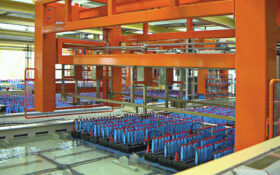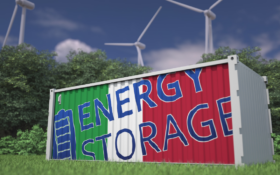Flow battery company Invinity Energy Systems reckons it is on the verge of profitability. Outgoing CEO Larry Zulch talked to Andrew Draper just before he retired on 6 September about the technology he believes will get them there. He thinks flow batteries still lack maturity to take full advantage of long-duration energy storage needs.

Invinity has been cutting its flow battery costs by 30% a year for the last two years, and plans to keep going. Zulch said he has no plans for the company to start giving them away, but there is still room for lower costs.
“We’re going to go as far as we can, he said. “I mean, there are so many different areas where we can make small improvements that add up to bigger improvements. So the question is, how close are we to making the maximum improvement we can in each of the areas of active materials, the balance of system, the operating and maintenance costs, the electrolyte. Each one of those still has room to go, but we don’t know how far.”
Zulch admits the company is not in control of the cost-setting and that it is a matter of negotiation. “We’re not in control. It’s a partner-relationship issue. You know, that’s the reality. We have to infect them with the vision of the future, this bright future that will occur when prices get below a certain threshold.”
Pricing is what the market will pay, he noted. A premium is obtained at an installation near a residential area where people are concerned about battery fires, he said.
Mistral

Its latest flow battery, on which it is pinning its hopes, is called Mistral. The first Mistrals coming out are really designed for more than 10MWh, Zulch said. He said the Mistral technology platform is inherently 30% less expensive than its flagship VS3 platform. It was co-developed with Siemens Gamesa.
Zulch unveiled Mistral at last year’s International Flow Battery Forum meeting in Prague. It is billed as some 60% more energy dense than the current battery line-up, significantly more efficient and with a levelised cost of energy of $0.06–7 per KWh.
The company says the product performance has been validated, and is on schedule for official product launch later this year.
Zulch told BEST the company will reduce the battery cost through working with its supply chain: “Mistral is a technology platform that is inherently 30% less expensive than our VS3 platform. So that’s a technology step. Then we’re going to gradually reduce the cost of building Mistral through working with the supply chain through higher volumes designed for manufacturing all those pieces.”
In an investor presentation in April, the company set out targets for Mistral, including 78% efficiency and cost of storage of $60/MWh, a 46% improvement on the VS3 battery.
Going global
Invinity is going global in its sales strategy, after initially focussing on the UK and North America. The company is listed in London and Zulch is based in San Francisco. It has partnered with Everdura, which has exclusive reseller status in Taiwan and is also a manufacturing licensee. The company lists partners in Korea and China.
Zulch said Invinity has handed Everdura the opportunity to use its IP to build the Mistral battery in Taiwan. “They have access to our supply chain without any financial commitment on our side. They purchase stuff out of our supply chain. We supply them stacks at cost, they purchase electrolyte made in Taiwan from spent catalyst, put it all together and meet this incredible amount of requirements that Taiwan has for non-lithium energy storage.”
Everdura will also export to neighbouring markets such as the Philippines, Vietnam and Japan. That poses a challenge for protecting Invinity’s IP, said Zulch.
Protected IP

“Some of our IP is embedded in our stack. And since we’re giving them a stack that’s already been assembled and is hard to learn everything with nuts that you can’t undo, they are under literally 10 tons of pressure, you know, because there are special washers that provide pressure to hold the whole thing together. So you do not want to take a stack apart without knowing what you’re doing.”
The assembly process causes some things to become deformed when put together so that helps keep the IP “relatively well protected at stack level”. Stack manufacture is done in-house at Invinity.
The other major area of IP is software. Invinity does not provide any source code, just functional software. The development relationship with Siemens Gamesa, Invinity’s development and commercialisation partner, covers everything with Mistral except for stacks and software, Zulch said.
Significant IP goes into the tanks, covering electrolyte distribution, for example. Invinity protects that through non-disclosure agreements and partnerships based on trust, which he calls critical.
Slower pace of cash funding
The slower pace of cash funding has delayed projects by some six months, according to Zulch. He said the company had hoped to complete its funding in 2023. It stated in its annual report for 2023 that it concluded a strategic investment from the UK Infrastructure Bank of £25 million ($32 million) and an investment from Korea Investment Partners of £3 million as part of a larger £57.4 million of fundraising completed in May.
In addition, as part of the capital raise in March 2023, Everbrite Technology Co, a leading Taiwanese manufacturer of industrial technology, subscribed for £2.5 million of Invinity shares.
“So that’s terrific,” Zulch said. “That puts us in a position to have enough money to fund our operations until we make enough positive margin off Mistral to be a business that’s cash flow positive. That was the purpose of the fundraising, to give us enough money to get where we need to go.”
Zulch said Invinity did not see the funds until May this year, after it was approved by shareholders. This was more than six months beyond what he hoped when Invinity started the process in 2023. This meant some schedules were pushed back. The company is aiming to achieve profitability or break-even next year.
Technological development
As for future technological development, he said the aim initially is to get Mistral out, then to work on improving it based on a principle of ensuring reliability, availability and lifetime (RAL).
“RAL is another thing that we’re trying to improve because that improves O&M and decreases costs, etc. So electrochemically, those kinds of benefits are immense because they don’t necessarily cost very much. Maybe a new membrane, maybe it costs a little more, maybe it costs a little bit less, but if it performs better, the whole system performs better. So that’s a piece of where things are headed.”
Grid curtailment
Zulch believes grid curtailment will stimulate long-duration energy storage. “There’s no question that curtailment stimulates the acquisition of storage,” he said. “But does it do it more for flow batteries than for lithium batteries?…I think it does support long-duration energy storage. And to that extent, it should support flow batteries. Are flow batteries ready right now to take full advantage of that? No, and that’s the problem and lithium batteries aren’t ready either for a different reason.”
There is a still a degree of immaturity in the flow battery product offerings, he said. And lithium batteries are not ready either because they have not progressed the technology to support long duration, he said.
Zulch was succeeded as CEO by Jonathan Marren.












